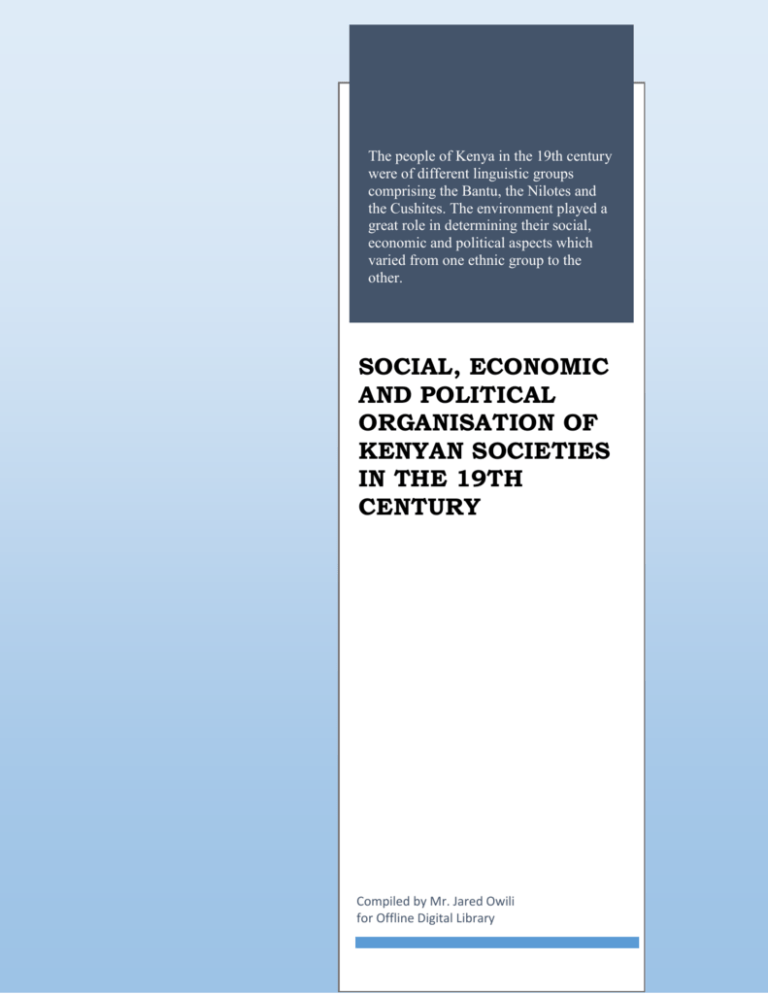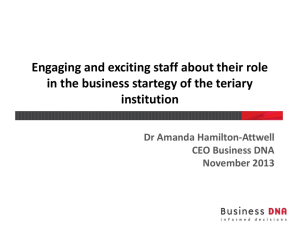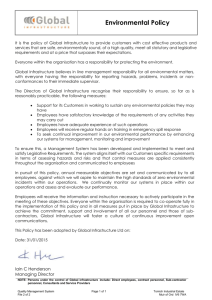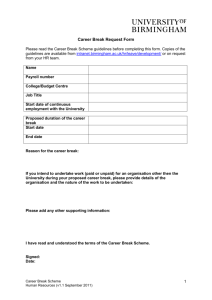social, economic and political organisation of kenyan societies in the
advertisement

The people of Kenya in the 19th century were of different linguistic groups comprising the Bantu, the Nilotes and the Cushites. The environment played a great role in determining their social, economic and political aspects which varied from one ethnic group to the other. SOCIAL, ECONOMIC AND POLITICAL ORGANISATION OF KENYAN SOCIETIES IN THE 19TH CENTURY Compiled by Mr. Jared Owili for Offline Digital Library SOCIAL, ECONOMIC AND POLITICAL ORGANISATION OF KENYAN SOCIETIES IN THE 19TH CENTURY. The people of Kenya in the 19th century were of different linguistic groups comprising the Bantu, the Nilotes and the Cushites. The environment played a great role in determining their social, economic and political aspects which varied from one ethnic group to the other. The Social, Economic and political organisation of the Agikuyu in the 19th century Social organisation The Kikuyu were organised into clans. There were nine clans. Some of them were Anjiru, Ambui, Acera, Angari, Angeci and Airimu. The family was an important social political unit because it acted as the basis of the Kikuyu community. Above the family was the “mbari” or sub-clan under “Muramati” or caretaker. The Kikuyu had age set which was acquired from the Gumba. They conducted birth and marriage ceremony. Men cleared the land, looked after the live stock and milked while women cultivated. The Kikuyu initiated (circumcised) boys and girls to adult hood. They worshiped a God they called ‘Ngai’ who lived on Mount Kenya (Kirinyaga). The Kikuyu offered sacrifices to their God for thanks giving in sacred places. They slaughtered goats and sheep as sacrifice. They had medicinemen, rain makers and prophets. A medicineman was known as “Mundu Mugo” and he cured diseases. They also believed in ancestral spirits. Finally they paid dowry in form of cattle, sheep and goats. Economic Organisation The Agikuyu grew crops such as millet, sorghum, arrow roots and yams. They traded with their neighbours such as the Maasai and the Akamba. They smelted iron for making hoes and axes and also weaved and practiced basketry as well as pottery. The Agikuyu hunted and gathered to substitute their diet. They kept beehives and harvested honey. Lastly, they kept livestock for example cattle, sheep and goats. Political Organisation: The Kikuyu were organised into clans-each made up of sub-clans called “Mbari”. They were politically organised into age –set systems composed of boys who were initiated. The Kikuyu community was decentralised and it had the institution of the ‘Muramati’ (clan leader). ‘Muramati’ co-ordinated all the activities of the sub-clan. There were warriors who defended the community. The Kikuyu had a council of elders (KIAMA) which maintained law and order and made final decisions. It presided over religious functions. Cases were handled by ‘Kiama’ composed of individual who acted as judges. Kikuyu and Meru settlements. The Social, Economic and Political organisation of the Ameru in the 19th century Social organisation. The Ameru who comprised the Chuka, Tharaka, Mwimbi, Muthambi, Imenti, Tigania and Igembe were organised into clans. The family was an important social institution. They were also organised into age-set systems (Nthuke/Irua) comprising of age mates. The Ameru conducted initiation ceremonies in form of circumcision. Both Girls and boys were circumcised. They worshiped God under the sacred Fig (Mugumo) trees and they also performed sacrifices to their God. The Ameru had medicinemen, rainmakers, fortune-tellers and prophets. They were ruled by a council of elders who also presided over religious ceremonies. Economic organisation. The Ameru grew crops such as millet and sorghum. They kept livestock such as cattle, sheep and goats and they hunted wild animals and gathered roots and fruits. Some Ameru traded with their neighbours such as the Akamba, Mbere and Embu. They were engaged in traditional industries such as pottery, basketry, weaving, cloth making and iron smelting which enabled them to make knives, spears, arrow heads and iron hoes. Finally, they kept beehives and harvested honey. Political organisation. They were ruled by councils of elders called “Njuri Nceke” and they were organised into clans made up of several families which were related. There were age-set systems comprised of men who had been initiated into adult hood. There were warriors composed of strong circumcised men who defended the community in times of problems. The Ameru were decentralised as there were different independent groups such as the Tharaka, Tigania, Mwimbi, Imenti, Igembe, Chuka, Igoji and Muthambi. Religious leaders played an important role in the administration of the Ameru and also foretold the future. The social, economic and political organisation of the Akamba in the 19th Century. Social organisation The Akamba were organised into clans made up of several related families. They had agegroups and age-set system. They practiced circumcision as an initiation rite. They believed in witchcraft and had medicine men and diviners. The Akamba conducted traditional ceremonies. Finally, they worshipped God and performed sacrifices to him. Economic organisation Some Akamba practiced crop cultivation and planted sorghum, millet, potatoes and beans while others kept livestock such as cattle, sheep and goats. The Akamba were skilled hunters and they also gathered fruits and roots to substitute their diet. They traded with the Kikuyu, Taita, Mijikenda and later with the coastal people. The Akamba sold honey, arrow poison and tobacco to them while they bought beads and cloth from the coast and also ivory and foodstuff from the interior communities like the Samburu and Mbeere respectively. They smelted iron and made spears, arrow-heads, hoes, knives, cattle bells and jingles. The Akamba were efficient beekeepers and they harvested a lot of honey. They were engaged in traditional industries where they manufactured pots, baskets, mats, stools and shields. Those who lived close to river Tana did some fishing. They made carvings from wood and sold them to the people in exchange for cloth, snuff boxes and beads. Political organisation Politically the Akamba were organised into clans made up of several related families. They had councils of elders each entitled to “Nzama Sya Utui”. They practiced the age-set system and they were ranked in age grades such as junior elders, medium elders, full elders and senior elders. The Akamba were decentralised. Akamba warriors defended the community. Judgement of cases was done by the council of elders. How the Abagusii were organised socially, economically and politically. Social Organisation The Abagusii were organised into clans. Their social organisation was based on the extended family whose members claimed to have a common ancestor. They conducted initiation ceremonies in form of circumcision for boys and clitoridectomy for girls. Polygamy was a very common social practice among the Abagusii. The Abagusii worshipped one supreme God called ‘Engoro’. They prayed through ancestral spirits. The Abagusii sacrificed to their God, Engoro who they regarded as the creator of the universe. They had medicine men, rain makers and prophets. Lastly, they also conducted ceremonies marking birth, initiation and death. Economic organisation. The Abagusii were pastoralists and they kept cattle, sheep and goats. They cultivated crops such as millet, sorghum, pumpkins, potatoes and beans. Men hunted wild game while women gathered wild fruits and roots. They conducted trade with their neighbours such as the Luo and the Luhyia. Finally, they were engaged in traditional industries such as making stone carvings and iron hoes for cultivation. Political organisation. The Abagusii were politically organised into clans made up of related families and each clan was ruled by “Omogambi”. They had age-set systems and councils of elders which led the clans in wars and judged cases. The Abagusii were politically decentralised. They had warriors who defended their territory from the enemies. The social, economic and political organisation of the Mijikenda in the 19th Century. Social organisation. The social organisation of the Mijikenda was based on the clan. They practiced the age-set system. Initiation of boys took place after every five years. The elders were the clan leaders. Inter marriages between Kayas existed. There was division of labour. Children looked after cattle, sheep and goats while young men built houses and cattle sheds, hunted and cleared the bush for cultivation. The Mijikenda worshipped God and offered sacrifices. They conducted ceremonies during the time of birth, initiation and marriage. Economic activities. The Mijikenda fished in the Indian Ocean. They kept livestock such as cattle, sheep and goats and hunted and gathered fruits, honey and vegetables. They were engaged in traditional industries such as weaving and basketry. The Mijikenda grew crops such as millet and also traded with the Swahilis and the people of the interior such as the Akamba. Political organisation The Mijikenda political set up was under the control of the clan. There were councils of elders who sorted out all matters concerning the ‘Kayas’. Age-set system existed. The Mijikenda had warriors who defended their territory and ensured that there was law and order. Cases were judged by the council of elders. The Social, economic, and political organisation of the Luo in the 19th Century. Social organisation The Luo were organised into clans composed of families with a common ancestor. The clans were grouped into larger territorial units called ‘Gweng’ which were occupied by foreign lineages entitled ‘Joka’ and clansmen. A council of elders existed which presided over religious ceremonies. The Luo worshipped a God called Nyasaye through their ancestral spirits. This was conducted in the sacred places. Priests existed who linked the people with the ancestral spirits. They had diviners who interpreted God’s messages to the people. The Luo sacrificed for thanks giving and for appeasing their God. They initiated boys and girls into adulthood by removing their six lower teeth. They also prepared them for marriage. Finally, the Luo conducted other ceremonies and celebrations such as burial ceremonies, naming, beer drinking and wrestling. Economic organisation The Luo cultivated crops such as beans, sweet potatoes, peas, millet, groundnuts and sorghum. They hunted wild animals and collected fruits, vegetables and roots. The Luo businessmen traded with their neighbours for example Abaluhyia, Abagusii, Nandi and Kipsigis. The Luo smelted iron and made iron tools and also engaged themselves in the traditional industries such as pottery, basketry and cloth making. They fished in Lake Victoria and in the rivers passing through their territory e.g. Rivers Sondu, Nzoia, Nyando, Kuja and Yala. The political organization The Luo were politically organised into clans and they were decentralised. The clans were made up of families headed by “Jaduong”. Several clans merged together formed a ‘gweng’. There existed a council of elders made up of clan heads and other remarkable elders. Related clans formed alliances and defended their territory. Each Luo alliance (Oganda) had a political leader entitled Ruoth. There were individual clan councils, doho, controlled by Ladito. Also there was a council called Buch Piny made up of elders who advised the Ruoth for example the military leader, Osumba Mirwayi. The council of elders was made up of clan heads and other remarkable elders. It solved internal disputes over land, declared war and performed other political and religious functions. Doho was a smaller council which operated under smaller regional sub-divisions. There were warriors referred to as Thuondi who raided the neighbouring communities. The social, economic and political organisation of the Nandi in the 19th century Social organisation The Nandi were organised according to totemic clans. The house was an important social unit and several houses made a family. The Nandi practiced initiation ceremonies like circumcision of boys during adolescence at five years intervals. They had age-set and agegrades. The age sets were cyclic. The Nandi people worshipped a supreme God and sacrificed to Him. This God was entitled Asis. They had medicine men, prophets and rain makers. The Orkoyiot acted as a spiritual leader although he was also a political leader. He foretold the future and also adviced the council of elders. Economic activities The Nandi practiced mixed farming because they grew crops and kept livestock such as cattle, sheep and goats. They smelted iron and made iron tools and weapons such as spears, cattle bells and hoes. The Nandi traded with their neighbours such as the Luhyia, Maasai and the Luo. They were engaged in traditional industries such as weaving, basketry and pottery. Some Nandi people hunted and gathered roots and fruits as well as vegetables. A few others harvested honey because they kept beehives. Political organisation The Nandi were organised into clans made up of several families. Their government was decentralised. They had councils of elders who solved major disputes. The Nandi had ageset systems. They had well trained warriors who defended their territory. The age-grade system gave rise to the warrior groups. The Nandi introduced the institution of Orkoyiot in the 19th century which helped in uniting the people. Towards the close of the 19th century the Nandi had also developed a society based on semi-independent units known as Bororoisiek/Bororiet. Each was under a council of elders. The Nandi had political units each made up of several clans and being controlled by the council they called Kok. The Kok judged cases and settled disputes. The social, economic and political organisation of the Maasai in the 19th c. Social organisation The Maasai were organised into clans and they had age-set systems. They conducted initiation ceremonies which promoted boys and warriors to the next age-set. After initiation one of them became “Olaiguanani”, or leader and spokesman. The Maasai worshipped a God called “Enkai”. They sent prayers to him through Oloiboni. Prayers were offered in shrines. They sacrificed to their God under sacred trees. The Maasai lived in Manyattas and their ways of life were based on preservation of cattle and grazing lands. They had had ritual experts and diviners. Lastly, the Maasai women and children constituted the lowest members of the society. Economic organisation The Maasai were predominantly a pastoral community although the Kwavi (Iloikop) section of the Maasai cultivated and grew millet and sorghum. The Purko section of the Maasai kept cattle and never cultivated crops. They traded with their neighbours such as the Luo, Nandi, Kikuyu and the Kamba people and hunted wild animals for meat and also gathered roots and fruits for food and medicine extracted from leaves, roots and stems of trees. The Maasai smelted iron and made iron tools such as knives, daggers, spears and arrowheads. They were engaged in traditional industries which included basketry and weaving. They also organised raids for cattle from neighbours especially during droughts. The Maasai women did supportive duties such as milking cows and building huts with mud. Political organisation The Maasai were politically organised into clans which were under the administration of the councils of elders. They did not have a centralised system of government because they existed in sub-tribal sections e.g. Purko, Kwavi, Sampur. Each sub-tribal section of the Maasai was independent of the other. The Maasai were under control of ritual experts entitled Oloibon. Succession to leadership among the Maasai was considered to be hereditary. This implies that after the death of the Oloibon, one of his sons was to take over control of the government. The Maasai men were grouped into age-sets and age-groups. There existed a strong army composed of warriors (Morans) who defended the Maasai territory and also expanded it through conquest. There were senior warriors who debated the major political issues of their community. Eunoto ceremony marked the graduation of Morans into junior elders. Finally, there were elders who had retired from public life and they were now consulted to help solve difficult political issues. The social, economic and political organisation of the Somali. Social Organisation. The Somali believed in the existence of God who was all powerful and who controlled everybody’s destiny. They conducted prayers to their God and sacrificed to him when need arose. The Somali later got converted into Islam through interaction with the Muslim immigrants. From the time they adopted Islam, they embraced Muslim culture. The Somali were socially organised into clans made up of related families. They conducted initiation of boys and then grouped them into age-sets. Economic organisation The Somali kept livestock such as cattle, sheep, goats and donkeys as well as camels. Those who lived near wells and rivers practiced a bit of cultivation. They also smelted iron and made iron tools and weapons e.g. swords. The Somali hunted wild animals and gathered birds’ eggs. They traded with their neighbours such as the Oromo. Political organisation The Somali were politically organised into clans whose members traced their origin back to a common ancestor. Each of the Somali clans was headed by a council of elders. The Somali were controlled by an overall leader known as the Sultan. The Somali clans joined together to face an enemy in times of crisis. There were age-sets which provided the community with warriors. The senior age-sets retired from active public life and were settled in different territories. The social, economic and political organisation of the Boran in 19th century. Social organisation The Boran is one of the Oromo speaking communities in Kenya today. The Boran people were socially organised into clans each made of related families. They had age-groups and age-sets which integrated the Boran community by facilitating co-operation among all the members of the community. The Boran believed in the existence of one God. The Oromo name for their God was Wak. At first the Boran were believers in traditional religion but by the end of the 19 th century many of them had been converted to Islam. Economic organisation The Boran were pastoralist and they kept sheep, cattle, goats and camels. They hunted elephants for ivory and sold them to the Swahili traders and other trading partners such as the Mijikenda and the Pokomo. Boran women collected and gathered a variety of items such as insects, roots and honey. The Boran were also engaged in simple industry for instance cloth making from animal skins and pottery. Some cultivated grains like peas, beans, pepper and vegetables. Political organisation The Boran like other Cushites were organised into clans and each of the clans was made up of related families. They had councils of elders who headed clans and presided over assemblies as well as acting as ritual experts. The council of elders settled disputes, maintained law and order and their decisions were final. They had age-set system which provided them with warriors who defended their territory from external attacks. The Boran clans were autonomous except in times of disaster when they formed alliances to fight against a common enemy Finally, the Boran were politically decentralised. Review Questions. 1. Identify the economic organisation of each of the following during the colonial period: a) Bantu communities b) Cushites c) Nilotes 2. Describe the political organisation of the following: i) Luo ii) Akamba iii) Abagusii 3. What was the role of the council of elders among the Ameru. 4. Why was the institution of the Orkoiyot important among the Nandi. 5. Discuss the social organisation of the following: i) Kikuyu ii) Boran iii) Maasai 6. What problems did the migrating communities encounter during the pre-colonial period?









